*This post may contain affiliate links. Read more »
Biji Salak are adorable little sweet potato dumplings that are great as an addition to dishes like bubur sumsum, or enjoyed as their own Kolak (a dessert with coconut milk and palm sugar syrup). Picture this: tender little orange dumplings swimming in a dark syrup, all topped off with a creamy coconut milk sauce and shaved coconut.
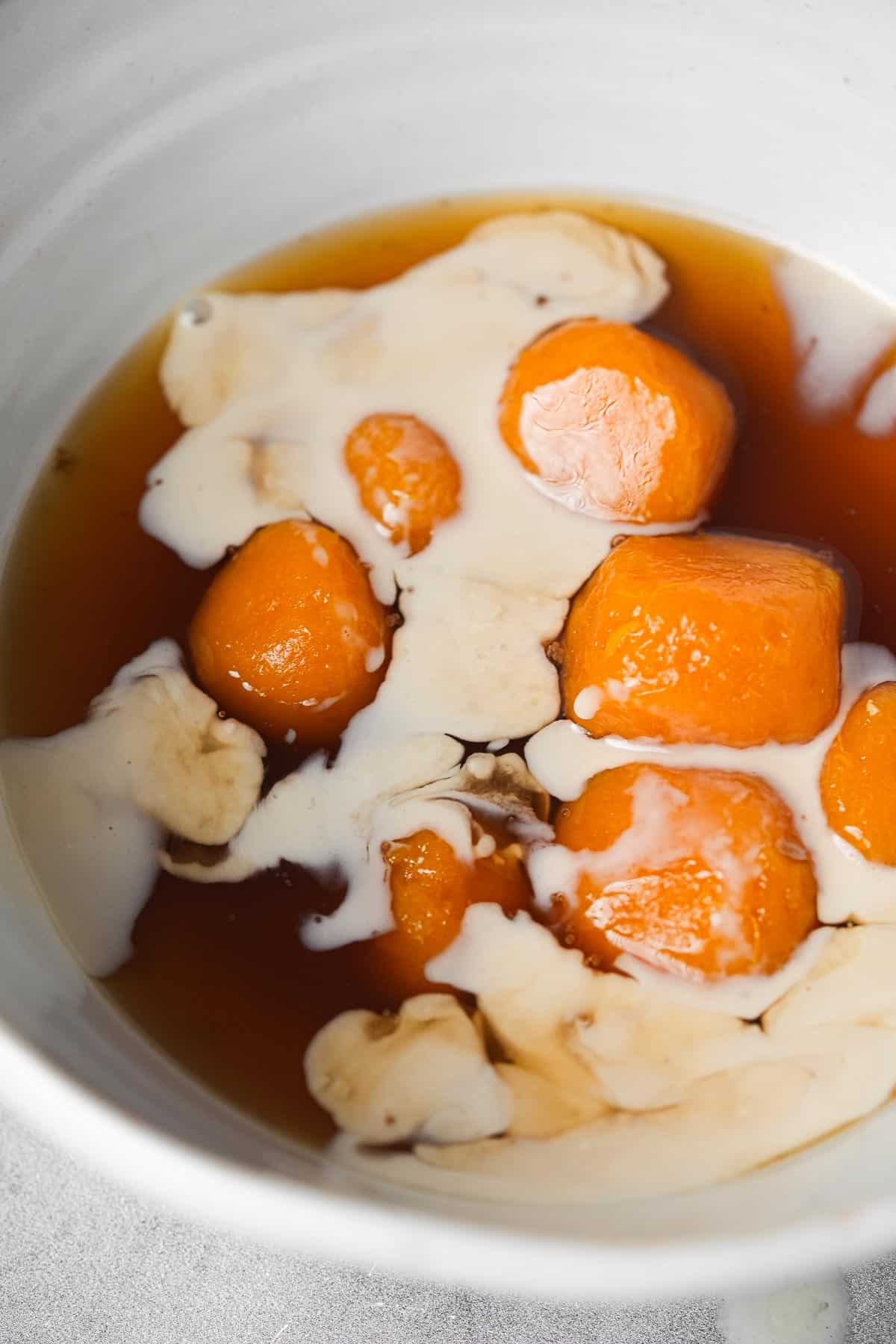

Enter your email & I'll send it to your inbox. Plus, get great new recipes from me every week!
By submitting this form, you consent to receive emails from Cinnamon Snail.
When people say that vegan and gluten-free desserts can’t be exceptional, it’s because they have never been to Indonesia or Malaysia where desserts like bubur cha cha and klepon absolutely DOMINATE!
Other than Bali, which is a Hindu island (and has killer dishes like urap sayur), Indonesia is mostly Islamic. During Ramadan in Indonesia, where fasting is observed, suhoor and iftar meals are significant. Biji Salak is a beloved traditional takjil dessert, enjoyed during this sacred month. Much in the same way that harira is taken by Muslims in Morocco.
Nail this on your first try with step-by-step photos, and clear instructions. In no time you’ll be savoring a bowl of this classic kolak biji salak!
Jump to:
🥰Why you'll adore this biji salak recipe
✊ Vegan AF: Sweet potato dumplings, palm sugar porridge, and creamy coconut sauce come together in perfect harmony- and like the vegan recipes I share, all are without a hint of animal products.
🥸 Fool-proof Method: With this well-tested, carefully crafted recipe, even kitchen novices and utter goofballs can master Kolak Biji Salak on the very first try. It’s like you have become a magical dessert chef overnight, and your whole neighborhood will cheer every time you step foot in the kitchen. No, for real, it’s like that.
🍠 Gluten-Free and Healthy: Dive into the nutritious goodness of sweet potatoes, packed with vitamins and fiber. This is not only gluten-free but also a sneaky way to get kids to fall in love with this wholesome veggie. A single sweet potato provides all the vitamin A people need in a day.
✅ Tested and Approved Worldwide: Just like all of the Indonesian recipes on my blog, this Kolak Biji Salak has been fine-tuned to perfection by me personally, and then rigorously tested by a global team of recipe testers. No matter where you are on the planet, rest assured this recipe will shine with any brand of ingredients and kitchen gear.


Warning: This Will Transform Your Vegan Indo Cooking!
This 6-day plant-based deep dive into the vibrant cuisine of Indonesia is 100% FREE.
🍠 Ingredients for this Indonesian dessert

🌿 Pandan
Pandan leaves, referred to as Screwpine in some regions, are a staple in Indonesian cuisine. They add a unique, fragrant aroma and a touch of green color to savory dishes like nasi minyak, nasi uduk betawi, and sweets like che ba mau, and kuih dadar. If you can’t find fresh pandan leaves, you can use a few drops of pandan extract or essence as a substitute. Try to find ones that don’t use artificial ingredients, but that can be tricky, which is why I always opt to use the leaves.
🍚 Tapioca Starch:
Tapioca starch, also known as tapioca flour, plays a crucial role in forming the sweet potato dumplings. It provides that delightful chewy texture, and can also act as a thickener in the case of taro pudding, and it works to make a crispy outside in the case of pisang goreng. It's such a versatile ingredeint to keep in your pantry! Cornstarch can work as a substitute in this recipe if you don’t have tapioca starch. Some people even use glutinous rice flour as a thickener instead of tapioca starch, and it works well too!
🌴 Palm Sugar
Palm sugar, or its close cousin, coconut sugar, is the sweet star of Kolak Biji Salak’s palm sugar syrup. These natural sweeteners bring a rich, caramel-like sweetness to dishes like cekodok pisang banana donuts and putu ayu cakes. For a quick swap, you can use brown sugar as a substitute.
🥥 Coconut Milk
Canned coconut milk is the base of the simple but rich coconut sauce. I recommend using full-fat canned coconut milk, but the recipe will work with other forms of coconut milk, and, in a pinch, even other plant-based milks like oat milk or almond milk. The substitutes will not be quite as rich though.
*See the recipe card at the bottom of the page for exact quantities, nutritional info, and detailed cooking directions.
🤯Variations
💜 Purple biji salak
Use purple sweet potato or ube (they are technically a little different and lighter in color) in place of the regular sweet potato in this recipe. You can swap them out 1-1, and the result is really pretty!
📐 Varied Indonesian sweet potato balls
I know, I know, things cook more constantly when they are all the same size, but hear me out. I think it looks really great to have a bowl of biji salak when the dumplings are a bunch of different sizes. If you want to do that, make three different sizes of dumplings, some two teaspoons, some four teaspoons and a small number that are a whopping two tablespoons in size.
When you boil them, add the largest ones first, then add the middle size about a minute later, and the tiny ones another 20 seconds after that. They will all end up rising and being done at roughly the same time, and they will look great in a bowl all mixed up.
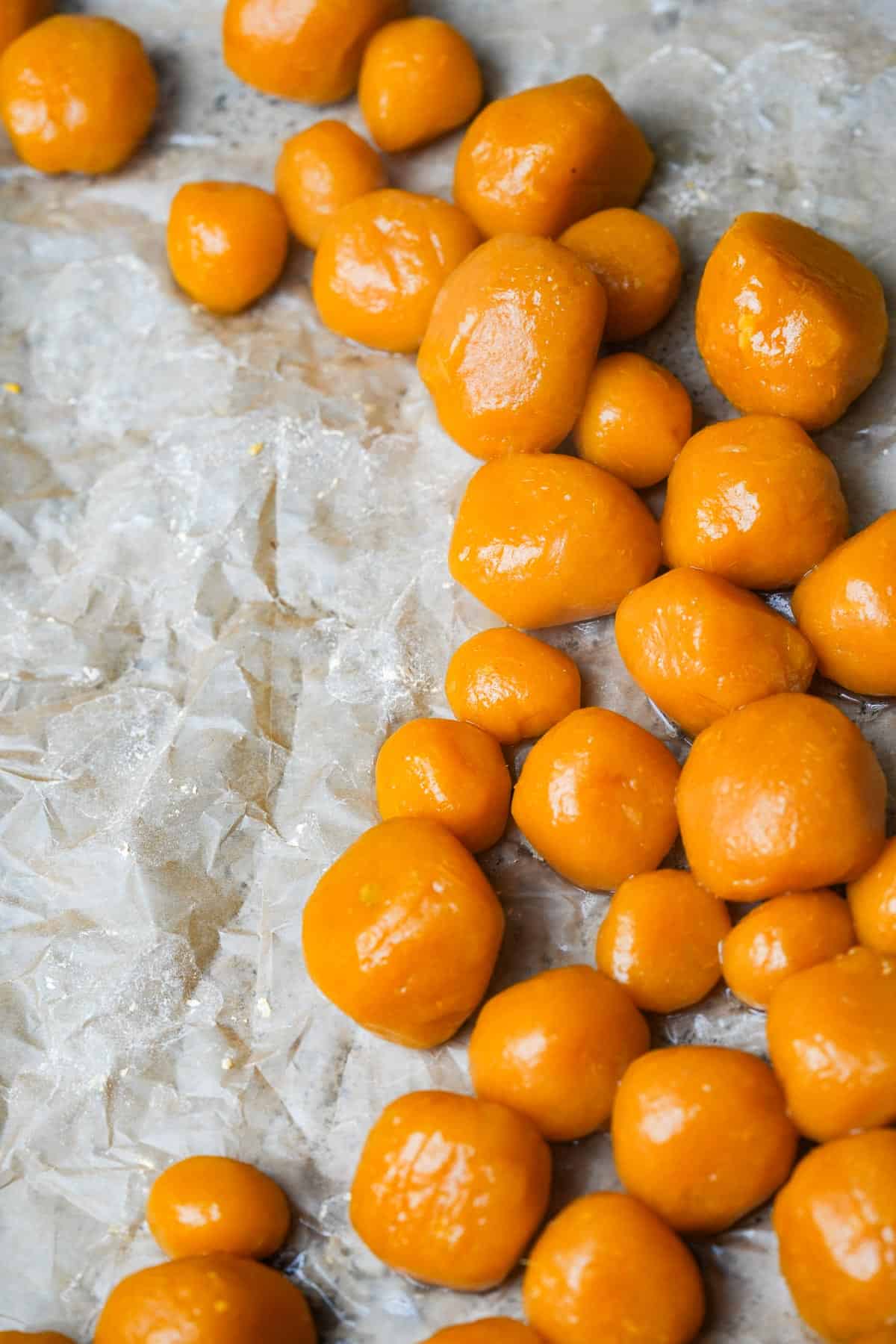
📖 How to make Kolak Biji Salak
Nail this Indonesian sweet potato kolak on your first shot by following these step-by-step instructions with important tips. Or you can follow along with the easy-to-print recipe card towards the bottom of this page.

Step One
Steaming Sweet Potatoes:
Steam or boil sweet potato pieces for 7 minutes until fork-tender. Let cool in a colander for 10 minutes.

Step Two
Mixing Dough:
Combine cooled sweet potato, tapioca flour, and salt in a large bowl. Knead until a smooth dough forms.

Step Three
Forming Dumplings:
oll dough into small balls, using one heaping tablespoon for each (unless you are going to make different sizes, see my note about that in the variation section above).

Step Four
Boiling Dumplings:
Boil water in a pot. Add sweet potato dumplings, cook for a few minutes until the balls float, then remove with a slotted spoon. The exact time it will take depends on the size you roll your dumplings.
➡️ It is critical that the water is boiling before adding the dumplings, or they will likely disintegrate into a starchy nightmare-mess, and you will cry yourself to sleep!

Step Five
Preparing Porridge:
In a saucepan, boil water with knotted pandan, palm sugar, and salt.

Step Six
Thicken the Palm Sugar Porridge:
Mix tapioca starch with water. Add it to the simmering liquid to thicken. Turn the heat off and set the palm sugar porridge aside.

Step Seven
Coconut Sauce:
Combine canned coconut milk, knotted pandan, salt, and vanilla extract in a saucepan. Simmer until fragrant and slightly thickened. Remove pandan.

Step Eight
Assembling Kolak Biji Salak:
In a bowl, ladle palm sugar porridge, add sweet potato dumplings, and drizzle with coconut sauce. Optionally garnish with grated coconut, mint leaves, and fresh pandan.
💡Serving Ideas
💡Serving Ideas
You can serve Kolak Biji Salak either hot or cold (I prefer hot because the warm dumplings are more chewy that way) as a delightful dessert to round off your Southeast Asian feast.
After savoring dishes like sayur lodeh with lontong, the sweet and chewy dumplings of Kolak Biji Salak provide the perfect sweet ending to balance out the savory flavors.
Some sambal goreng tempeh, miso glazed eggplant, or tahu goreng over nasi kunyit (steamed Indonesian turmeric rice) could be just the first course to consider before Biji Salak.
Smash a bowl of this after your favey noodle dishes like mie goreng, ketoprak, khao suey, bami goreng, stir-fried vermicelli, or pad woon sen with pickled green chilies.
Don’t sleep on other vegan sweets like martabak manis, Vietnamese bành flan, or coconut milk crème brûlée if you are on an uncontrollable dessert spree.

👉Top tips
- Texture Matters: Achieving the chewy sweet potato balls is crucial. Knead the dough until it’s smooth and pliable. This is also why I recommend peeling the sweet potatoes before steaming them. The skins are healthy but will make for a wacky texture in this.
- Pandan Hackery: Pandan leaves are an important aromatic element in this recipe. That's why I bring them up to a boil with the water in the recipe before adding the other ingredients, so that there is more time to draw out the flavor from the leaves.
- Consistency is Key: Pay close attention to the consistency of the palm sugar porridge and coconut sauce. Use tapioca starch to thicken the porridge to your preferred thickness and ensure the coconut sauce is fragrant but not overly thick.
🤷♀️FAQ
In the Indonesian language, “biji salak” means “snake fruit seed.” This name is a nod to Indonesia’s native snake fruit (which looks like the skin of a snake from the outside), as the sweet potato balls’ shape and color share a likeness with these inner seeds.
For those of you who know sanskrit, you can see the origins of the name Biji from the saksrit word Bija बीज. Sorry to nerd out, but that's like my fave stuff to study...
Made too much mashed sweet potatoes? No biggie, you can either:
Make these classic sweet potato donuts from Peru.
Make these silly-easy and fast vegan sweet potato muffins.
Feed them as a snack to your soft, soft doggy who you love with all of your heart.
Yes, you can substitute regular sugar, but add a touch of molasses to help replicate the mineral-rich taste and dark color of the palm sugar. Coconut sugar is really a better alternative to palm sugar if you have it.
The dumplings are ready when they float to the water's surface, typically in a few minutes depending on the size of the balls.
I don't recommend freezing the sweet potato dumplings, as they totally dry out upon thawing and reheating. The texture just isn’t great this way.
Store any leftover Kolak Biji Salak by placing the different components into airtight containers in the refrigerator. It can be stored like this for up to three days, maintaining its flavors and textures.
💦 ➡️ The main thing is to store the sweet potato dumplings in water so they do not stick to each other.
🔥 Stovetop Reheating:
To reheat Kolak Biji Salak, Heat the palm sugar porridge in a saucepan over medium heat.
Separately blanch the dumpling in boiling water, or steam them for a few minutes to heat them through.
Then assemble the individual servings as you normally would and add fresh garnishes to spruce things up. No one will even know it wasn’t fresh made that day!
✌️My faves to serve with biji salak:

Kolak Biji Salak (Indonesian Sweet Potato Balls)
Equipment
- Deep saucepan
Ingredients
Sweet Potato Dumplings
- 1 lb. sweet potato (454 grams) peeled and diced (its about 4 cups diced)
- 1 ½ cup tapioca flour 190 grams
- ½ teaspoon salt
Palm Sugar Porridge:
- 4 cups water
- 1 cup palm sugar or coconut sugar
- ½ teaspoon salt
- 3 pandan leaves chopped or knotted
- 2 tablespoons tapioca starch
- 3 tablespoons water
Coconut Sauce:
- 1 coconut milk
- 3 pandan leaves knotted
- 2 tablespoons palm sugar
- ¼ teaspoon salt
- ½ teaspoon vanilla extract
Optional Garnishes:
- ¼ cup grated fresh coconut
- 10 mint leaves
- Sliced fresh pandan leaf
Instructions
Sweet Potato Dumplings:
- Steam or boil the sweet potato pieces for about 7 minutes until fork tender. Cool them in a colander for ten minutes so that they can be comfortably handled.
- In a large mixing bowl, combine the cooled sweet potato, tapioca flour, and salt. Use your hands to knead the mixture until it forms a smooth, dough-like consistency.
- Roll the dough into small balls, using about 1 heaping tablespoon for each ball.
- Bring a pot of water to a rolling boil over a high flame. Add the formed sweet potato balls to the boiling water and cook for just a couple of minutes until they rise to the surface. Carefully remove them with a slotted spoon.
Palm Sugar Porridge:
- In a deep saucepan, bring the water, knotted pandan, palm sugar (or coconut sugar) and salt to a boil over high heat.
- In a separate small bowl, mix the tapioca starch with water to create a smooth paste. Remove the pandan leaves and slowly pour the starch slurry into the simmering sugar water, stirring continuously. Once bubbling, turn off the heat, and set aside.
Coconut Sauce:
- In another saucepan, combine the canned coconut milk, knotted pandan leaves, half a teaspoon of salt, and half a teaspoon of vanilla extract. Heat this mixture gently over low heat while stirring. Allow it to simmer for a few minutes until it's fragrant and slightly thickened. Remove the pandan and set aside.
Assembling Kolak Biji Salak:
- To serve, ladle a generous amount of palm sugar porridge into each bowl, add a few sweet potato dumplings, and drizzle with the aromatic coconut sauce. Optionally garnish with grated coconut, one or two mint leaves and a thin slice of fresh pandan.
Notes

Enter your email & I'll send it to your inbox. Plus, get great new recipes from me every week!
By submitting this form, you consent to receive emails from Cinnamon Snail.


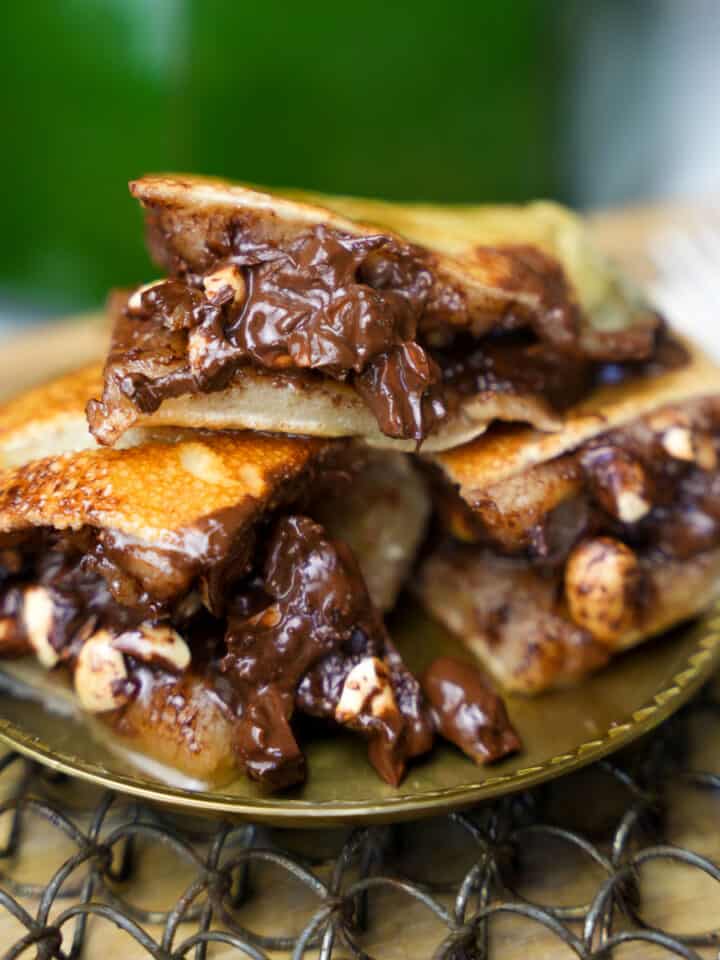

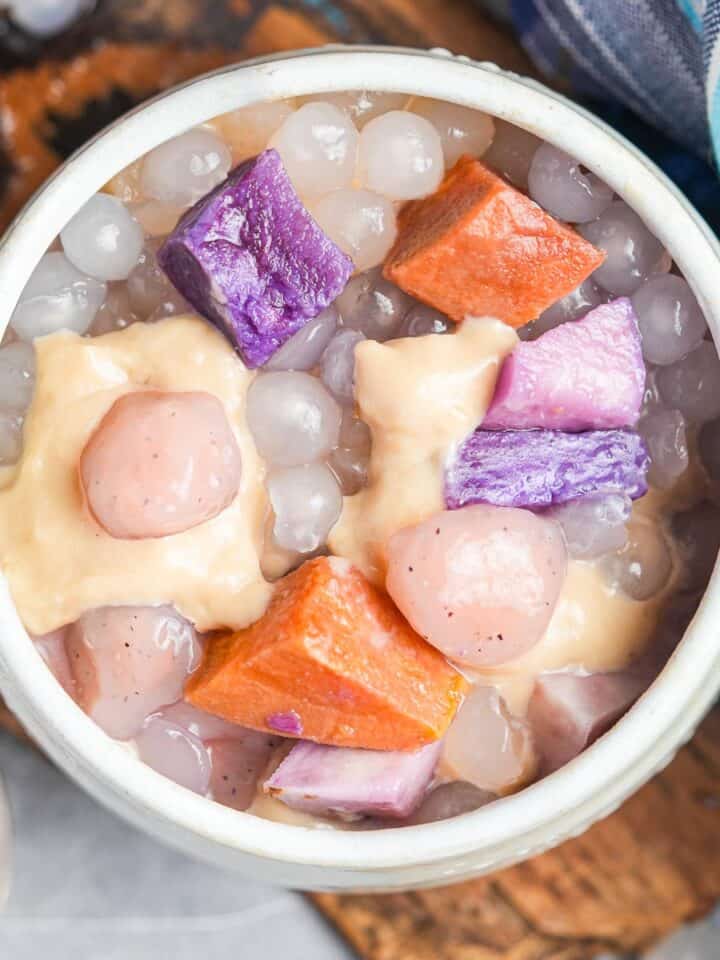





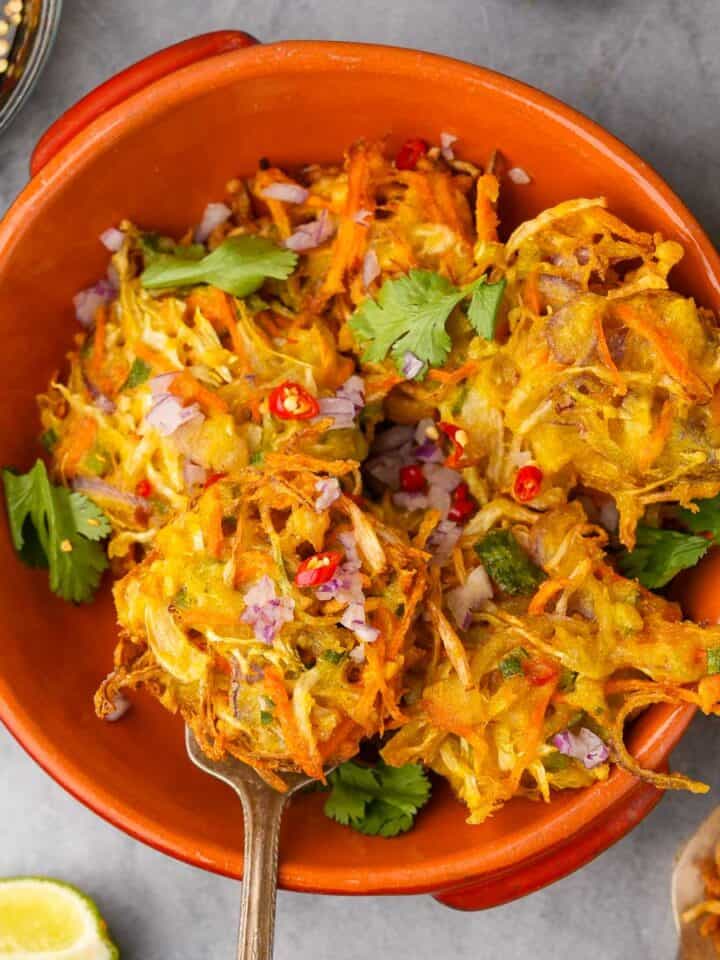
Leave a Reply